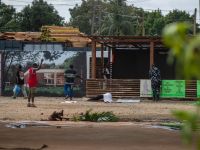Mount Sinjar stinks of death. The few Yazidis who have managed to escape its clutches can tell you why.
‘Dogs were eating the bodies of the dead,’ said Haji Khedev Haydev, 65, who ran through the lines of Islamic State jihadists surrounding it.
On Sunday night, I became the first Western journalist to reach the mountains where tens of thousands of Yazidis, a previously obscure Middle Eastern sect, have taken refuge from the Islamic State forces that seized their largest town, Sinjar. I was on board an Iraqi Army helicopter, and watched as hundreds of refugees ran toward it to receive one of the few deliveries of aid to make it to the mountain.
The helicopter dropped water and food from its open gun bays to them as they waited below. General Ahmed Ithwany, who led the mission, told me: ‘It is death mountain. Up to 70 per cent of them are dead.’ Handfuls of refugees have managed to escape on the helicopters but many are being left behind because the craft are unable to land on the rocky mountainside.
There, they face thirst and starvation, as well as the crippling heat of midsummer. The Iraqi Army is running several aid missions every day, bringing supplies including water, flour, bread and shoes. Even when it can land, the single helicopter can take just over a dozen refugees at a time, and then only from the highest point of the mountain where it is out of range of jihadist missiles. Barely 100 have been rescued in this way.
The flights have also dropped off at least 50 armed peshmerga, Kurdish forces, on the mountain, according to Captain Ahmed Jabar. Other refugees have made their way through Islamic State lines, evading the jihadists to reach safety, or travelling through Kurdish-controlled sections of Syria to reach the town of Dohuk. So far the Yazidi refugees left behind have survived by hiding in old cave dwellings, drinking from natural springs and hunting small animals.
But with families scattered across Mount Sinjar, a range stretching for around 35 miles near the border with Syria, there are fears aid will not reach them all unless the humanitarian relief operation is significantly stepped up. Hundreds can now be seen making their way slowly across its expanse, carrying what few possessions they managed to flee with on their backs. Exhausted children lie listlessly in the arms of their parents, older ones trudging disconsolately alongside while the sun beats down overhead.
The small amount of relief the peshmerga militia can bring up into the mountain is not simply enough. One fighter, Faisal Elas Hasso, 40, said: ‘To be honest, there’s not enough for everyone,’ he said. ‘It’s five people to one bottle.’ The refugees who made it out described desperate scenes as they awaited help from the outside world. ‘There were about 200 of us, and about 20 of that number have died,’ said Saydo Haji, who is 28. ‘We can live for two days, not more.’
Emad Edo, 27, who was rescued in an airlift on Friday at the mountain’s highest point explains how he had to leave his niece, who barely had enough strength to keep her eyes open, to her fate. ‘She was about to die, so we left her there and she died,’ he said. Others shared similar stories. ‘Even the caves smell very bad,’ Mr Edo added. According to several of the airlifted refugees, the Geliaji cave alone has become home to 50 dead bodies.
Saydo Kuti Naner, 35, who was one of 13 Yazidis who got through Islamic State lines on Thursday morning, said he travelled through Kurdish-controlled Syria to get to Kurdistan. He left behind his mother and father, too old to make the rough trip, as well as 200 sheep. ‘We got lucky,’ he said. ‘A girl was running [with us] and she got shot.’ This gave enough cover for the rest of them to get away.
Mikey Hassan said he, his two brothers and their families fled up into Mount Sinjar and then managed to escape to the Kurdish city of Dohuk after two days, by shooting their way past the jihadists. Mr Hassan said he and his family went for 17 hours with no food before getting their hands on some bread.The situation in Sinjar has irreparably damaged the notion of home for the Yazidis. For a large portion of them, the unique culture of the area will never return, and they will therefore have nothing to go back for.
‘We can’t go back to Sinjar mountain because Sinjar is surrounded by Arabs,’ said Aydo Khudida Qasim, 34, who said that Sunni Arab villagers around Sinjar helped Islamic State take the area. Now he as well as many of his friends and relatives want to get out of Iraq altogether. ‘We want to be refugees in other countries, not our own,’ he said.








